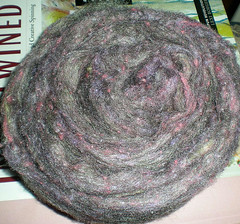 Quill heads for spinning wheels have been having a resurgence in popularity, due to the interest art yarns fueled by fiber artists such as Lexi Boeger and her book Intertwined.
Quill heads for spinning wheels have been having a resurgence in popularity, due to the interest art yarns fueled by fiber artists such as Lexi Boeger and her book Intertwined.Quill heads have the advantage of being able to take up yarn of any size -- there is no orifice for doll parts, sequins, bows, or other whatnots to travel through. Also, there is no take-up to have a tug-of-war with, but a nice stiff quill to keep tension against. I found this terrifically helpful in spinning elastic thread core yarn!
However, on standard spinning wheels, there are some things to consider. Castle/upright wheels and many Saxony/traditional wheels put the orifice right above the treadles. The quill attachment on most wheels sticks out a good 4-6 inches further than the orifice. For short folks, this puts it really close to your hands when you treadle. And you're going to need to treadle.
This however deserves consideration, because you spin off the quill by keeping your fiber/yarn in the making at about a 45 degree angle to the point of the quill -- quite an arm stretch if your quill is just above your treadles.
Some wheels have the flyer/quill off to one side -- my friend's Jensen Saxony is this way, and my own Majacraft can have the flyer tilted to be at one side of the treadles.
My all-time favorite for a quill attachment, however, is my electric wheel -- no treadles!
If you are curious about quills, try an experiment first. Check your wheel's orifice:
- Delta orifice -- sorry, you can't do the experiment. But most delta orifices will let a fair bit through them, so depending on how broad your art-yarns get, you may be fine.
- Elliptical orbiting orifice (Louets have this) -- sorry, you also can't do the experiment. Luckily, Louets have big orifices, so they also let most insertions through.
- Orifice simply rotates around the center of the orifice -- yay! continue with the experiment.
Measure the diameter of your rotating orifice (not when it's rotating, silly!). Go to the hardware store and buy wood dowel of that diameter. Usually this comes in four foot lengths ... that would be a bit long, so if you need to pick up a hacksaw too, do it. Cut a length about 6 inches long (heck, cut a 4.5", 6.5", and 8.5" length -- you'll still have leftovers!). Use a penknife or really big pencil sharpener to put a blunt tapered point on one end. Guess what -- you've made a quill!
Put the quill in your wheel's orifice. You might want to wrap masking tape around the end (sticky side on the quill) to make it fit more tightly in the orifice. Now, you can spin on this. It's up to you if you put a bobbin on your wheel or not ~ you won't be using it. Double drive wheels can simply put both drive bands in the flyer whorl if you don't put a bobbin on.
Put a leader on the quill up near the orifice, just like you put a leader on your bobbin. As you treadle (or turn your electric wheel on), the leader will barberpole up the quill and then flick off the end ... it will go flick, flick, flick off the end. This is normal, you are putting twist into the leader. OK, attach your fiber and start adding twist to it, instead.
 Once you have an arm's length, you'll have to stop, unwind the barberpoling, and then build up a cop on your quill. I'd recommend an X-style wind-on for speed, just like I use on my spindles. fill the top half (closer to the orifice) with your yarn, barberpoling back out to the tip and continuing to spin a new length of yarn.
Once you have an arm's length, you'll have to stop, unwind the barberpoling, and then build up a cop on your quill. I'd recommend an X-style wind-on for speed, just like I use on my spindles. fill the top half (closer to the orifice) with your yarn, barberpoling back out to the tip and continuing to spin a new length of yarn.So, if you've used the dowel-quill, you can evaluate the layout of your wheel for quill use. And then decide if the dowel is good enough, or if you'd like the more formal quill attachment if your wheel maker provides one.
